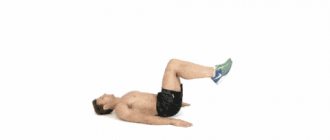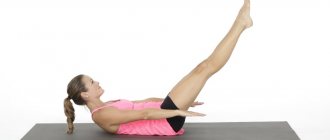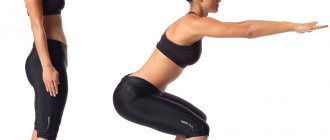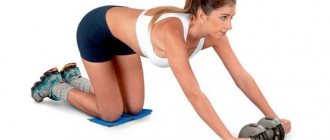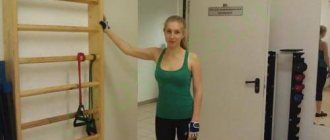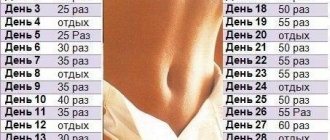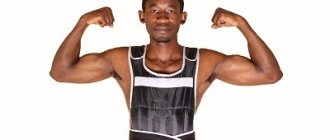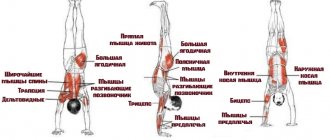Many people who go to the gym set themselves the goal of pumping up their abs, but even intense workouts often do not provide noticeable results.
An effective program includes not only correctly selected exercises aimed at the appropriate muscle groups, but also implies compliance with the basic rules for their implementation. This article can help you understand these issues.
What should a set of exercises consist of?
The selected complex may include various exercises, but it must be based on a plan to form a uniform body relief.
Namely:
- Exercises aimed at pumping up the muscles of the lower abs are suitable for starting a workout.
- Exercises for the muscle groups of the upper abs.
- Exercises aimed at the oblique muscles must be performed at the final stage of training.
It is necessary to follow this exact order of doing the exercises, since the lower abs are weaker than the other muscle groups, and the lateral parts have a higher volume, so more strength is required to work them out.
In some cases, adjustments can be made to the program if a local effect on the weakest and most problematic areas of the body is necessary.
Introduction
For some, the abdominal muscles are an indicator of an athletic physique; for others, the cult of the abs turns their life into continuous twisting and leg lifts. Indeed, clearly defined abs look very impressive, but with a thin physique, bringing them to this state is not at all difficult, since due to the low level of body fat, even not particularly developed abdominal muscles will be visible quite clearly. Try to gain 70, 80, 90 kg of muscle mass and have clearly defined abs. I'm sure this will be an elusive goal for many, if not all. And only the most effective abdominal exercises will help you achieve this result.
The abdominal muscles are divided into the rectus abdominis, internal obliques and external obliques. At the same time, the rectus abdominis muscle is usually divided into upper and lower sections. All these muscles and sections are usually trained with various types of twists, turns, leg and body lifts. It is these exercises that will be discussed in this article.
How to create a program?
A program designed to pump up the abs in the gym is always performed in a circuit pattern - this allows you to reduce energy consumption while maintaining high intensity. Performing the exercise in a circular manner further maximizes the rate of fat burning.
The basic rules that should be followed when drawing up a program for the press are as follows:
- Maintaining a strict sequence of exercises performed , taking into account the muscle groups being worked.
- Within one lesson, 3 approaches are performed.
- There is a one-minute break between approaches ; It is impossible to increase the time allotted for rest.
- The number of repetitions for each exercise depends on the presence of weights and working weight: when using a large weight, the minimum number of repetitions is performed; when training without weights, the number of repetitions should be maximum.
- At the initial stage of training, it is better to refuse weights, honing the correct technique for performing exercises. Gradually, the body will get used to the load and a maximum of repetitions will be reached, after which their number can be reduced as the weight increases.
- Particular attention is paid to the speed of execution : when exercising at a fast pace, a large number of muscle groups are involved and worked out - this increases endurance well, but actually has no effect on increasing muscle volume. The best option is to conduct training at an average pace or alternating speeds; these parameters are determined depending on physical fitness and individual characteristics.
When creating a program for the gym, you don’t have to worry about pumping up your abs, since this muscle group continues to grow to a certain level, after which its growth stops.
Training programs for men
For men, one or two abdominal workouts per week will also be quite enough. However, for men everything is somewhat more complicated. If you're training hard and performing, for example, deadlifts and heavy squats in the same week, your ab workout should be placed as far away from them as possible so that the muscles have time to recover. If you still feel soreness in your abdominal muscles, you should not work with heavy weights - it will be more difficult for you to maintain balance, the axial load on the spine will increase, and you may get injured. Most often, an athlete suffers a sprain of the spinal extensors; this injury takes at least several weeks to resolve.
For most men, one abdominal workout per week is enough. But there is nothing wrong with using abdominal exercises as a warm-up at every training session.
Many people do this: they start every workout with abs. This warms up well, since the rectus abdominis muscle contains a large number of nerve endings, the body quickly comes into a state of combat readiness.
During the period of gaining muscle mass, many men completely ignore abdominal training, citing the fact that they already receive enough load during basic exercises. There is some rationale to this, but even while gaining weight, abdominal training will benefit you: your core will become stronger, you will be able to lift more weight in all basic strength movements, improve your posture and prevent yourself from developing an umbilical hernia.
Men typically combine abdominal training with a larger muscle group, such as the chest, shoulders or back. It is not recommended to pump your abs after training your legs. Below are two options for abdominal training, the first is more powerful, the second is more functional, developing strength endurance. If you train your abs twice a week, do both workouts, if once, alternate.
So, an abdominal training program in the gym for men might look like this.
First training
| Exercise | Number of approaches and repetitions | Rest time between sets |
| Crunches in the simulator | 3x15 | 1 minute |
| Lateral bends with dumbbells | 4x12 | 1 minute |
| Exercise corner | 3x15-20 | 45 seconds |
| Plank exercise with additional weights | 3 – to failure | 1.5 minutes |
How to pump up abs for girls?
The training programs compiled for girls and men have fundamental differences.
Features of pumping up the press for girls are as follows:
- No need for additional burden. Doing exercises with your own weight will be enough to work the abdominal and side muscles, so you can give up dumbbells and opt for a fitball. Exercises performed with its help have a complex effect on the upper and lower abs.
- The effectiveness of side bends with weights is a myth; such exercises should be excluded from the program. They increase the volume of the corresponding muscles and do not contribute to the burning of fat deposits, so the result of such training will be a visual increase in waist width.
- After pregnancy, many women experience separation of the rectus abdominis muscles along the midline, which makes the abdomen look saggy and flabby. This is a direct contraindication for performing most standard exercises for pumping up the abs; you can check its presence in the following way: take a lying position on your back, bend your legs at the knees, raise your chest and head by tensing your abdominal muscles, and use your fingers to feel the line below the navel. The presence of a dip is a sign of divergence of the rectus muscles along the midline.
Side press: training secrets
It is important to separately note that the group of oblique and lateral abdominal muscles consists of a fairly large number of subgroups attached at different angles to the pelvis and ribs. In fact, the postural characteristics of each person make the anatomy of these muscles unique - unfortunately, there is no single correct strategy for training the lateral press
However, there are general rules for training the lateral press, which Fitseven already wrote about above - performing bends and various twists without additional weighting and with complete mental control over the work of the muscles. Essentially, you have to find the movement that works for you (and that you really feel) and then perfect the technique.
Mistakes in training
Exercises with weights (for example, side bends with dumbbells) are more effective for working the rectus abdominis muscle and creating six-pack abs. The obliques require moderate to high repetitions of crunches and other bodyweight exercises performed at varying angles—at a slow speed and perfect technique.
Let us remind you once again that before moving on to using weights, it is extremely important to learn how to perform exercises with full control of the abdominal muscles. In other words, you should feel that it is the lateral press that is working, and not the muscles of the spine and core
Therefore, the use of dumbbells by beginners can only hinder rather than help.
***
The lateral abs and obliques are the largest muscle group in the core, forming not only abs of steel but also providing support during core exercises. Key to the development of this muscle group are various variations of lateral crunches, performed slowly and with complete control over the movement.
Material rating:
How to pump up your oblique abdominal muscles? The best side press exercises,
4.05 / 42
You need to enable JavaScript to vote
How to pump up abs for men?
The compiled program should also take into account the characteristics of the male body, only in this case it will be effective and will help pump up the abs.
The main recommendations are given below:
- For men, their own weight will not be enough to properly work out their abs, so they definitely need to use dumbbells as weights. The weight increases gradually, and at the same time the number of repetitions of the exercises will decrease.
- The only restrictions are prohibitions related to existing diseases or previous injuries. Healthy men can practice any variety of crunches, leg raises, and weighted bending exercises. This approach to training will not only pump up your abs, but at the same time improve the condition and appearance of other muscles.
- Using exercise equipment during exercise can increase the effectiveness of your workout, especially if you have excess fat deposits. The “Lumberjack” exercise, bending on block machines and crossover crunches have several advantages: the ability to independently adjust the weight and local work on the most problematic areas.
Reverse crunches
This abdominal exercise involves the lower part of the abdomen, as well as the oblique abdominal muscles. This is a basic exercise used to develop strength and strengthen the lower abs. Recommended for everyone, from beginner to experienced athlete at the beginning of an ab workout.
Exercise technique
1. Lie on a horizontal bench with your head close to the edge. With your hands, grab the bench above your head. Bend your legs at the knees and keep them suspended, bent at a right angle. 2. Inhale and hold your breath, pull your knees towards your chest. At the top point, the pelvis is suspended, the back should be rounded, the knees should be as close to the chest as possible. 3. You can exhale after overcoming the most difficult section of the amplitude. Then immediately, slowly, return your legs and back to their original position. 4. At the bottom point, the legs remain above the bench, knees bent 90 degrees. Lowering your legs, inhale and continue doing the exercise.
Technique tips
- To achieve maximum contraction of the abdominal muscles, at the top point of the amplitude it is necessary to lift the pelvis off the bench.
- To achieve maximum contraction of the lower back muscles, try to pull your knees not towards your chest, but towards your head. This will also increase the flexibility of the lumbar region.
- Try not to twist too much or raise your knees further than your head. This will shift the center of gravity to the cervical spine, and you risk injury.
- At the top point of the amplitude, try not to straighten your legs. This way you will round your back by inertia, which will reduce the effectiveness of the exercise.
- At the lowest point of the amplitude, never lower your feet onto the bench. As soon as the legs are placed on the bench, the load from the abdominal muscles is removed, and the thigh muscles are included in the work.
- Fix the position of your legs for the entire approach and do not turn them. Excessive leg movements will bend the spine, which can injure the intervertebral discs.
- Holding your breath allows you to stabilize your body position on the bench and develop a much more powerful force while lifting your legs.
- An easier version of the exercise is lying on the floor. You place your arms along your body, which will significantly increase body stability and reduce the likelihood of unnecessary movements.
- The floor variation allows you to make the exercise more challenging by slightly raising your head and shoulders. This will force you to keep your abs contracted for the rest of the set.
- To make the exercise more challenging, try doing it with your legs fully extended. This will put even more stress on your lower abs.
Upper abs exercises
To work out the muscles of the upper abs, perform the following exercises.
Crunches
- To perform crunches, you need to take a sitting position on the machine, fix the position of your legs and grab the handles.
- From this position, the body is tilted towards the knees, which leads to twisting of the body, and then return to the starting position.
- Depending on the type of machine you choose, resistance is provided by lifting a weight or pressing your chest against a support.
- The exercise allows you to effectively pump not only the upper abs, but also use the serratus anterior and oblique muscles.
"Penknife"
- The “pocket knife” refers to the basic exercises for working the upper abs.
- It is necessary to take a lying position, stretched out on the floor and placing your hands behind your head.
- Exhale the air from your lungs and simultaneously lift your body and both legs up.
- When you reach the end point, pause for 1-2 seconds and smoothly return to the starting position.
- Legs and arms should not be lowered to the lowest point; keeping them at a short distance from the floor will allow you to more effectively work on the abdominal muscles.
Classic leg turns
- To perform this exercise for the upper abs, you need to lie on the floor, raise your legs at a right angle relative to its surface.
- The lowering of the legs is carried out first straight, and the second time - on the sides.
- It is necessary to monitor their position relative to the floor: it is important to maintain a distance of about 15-20 cm.
- Rotating the legs in this position directs the main load to the upper abs, but at the same time, the lower muscles are also involved.
Hip lift
- You need to lie on the floor and extend your arms parallel to your body, with your palms facing down.
- An alternative position for the gym: placing on an incline bench, which you need to hold on to with your hands above head level.
- After exhaling from your lungs, raise your legs at an angle of 90°, and then take a deep breath and return them to the starting position.
- To effectively pump up the abs, it is important to follow a number of rules: raise the pelvis along with the legs, eliminate sudden movements and jerks, and minimize bending of the legs.
Raising the body on an incline bench
- Another exercise for the upper abs is the incline sit-up.
- To do this, you need to sit on its upper edge, fix the position of your legs and lean back slightly.
- When in its original position, the body should be parallel to the floor surface, then lift it at a right angle and return back.
- For convenience, your hands can be placed behind your head, behind your back or crossed over your chest.
- When you reach the top point, you should pull your stomach as close to your hips as possible, and at the bottom point, ensure that your body is parallel to the floor.
At CrossFit Santa Cruz, we have four Glute-Ham Developer (GHD) machines. We use them for back extensions and sit-ups, writes Greg Glassman in an article on GHD sit-ups (also commonly called "Roman chairs") published in The Complete Guide to CrossFit Workouts.
GHD lifts were once common in gyms (staples). In gyms today, it's rare to see anyone doing anything other than back extensions on a GHD. In no small part, the neglect of the GHD or Roman chair coincided with the invention of the crunch. Crunches have come into fashion thanks to media claims that traditional sit-ups are bad for your back. It was argued that the style of GHD sit-ups was driven by the pelvic flexors rather than the abs, and therefore is not a great exercise for the abdominals. Moreover, it has been stated that using the pelvic flexors to lift the body is detrimental to the spine. Once every few years we get lucky and find another sports physiologist repeating claims about poor abdominal activation and lower back destruction when using the GHD. We then ask the exercise physiologist to climb onto the machine and perform a set of 30 reps to test the claim of under-abdominal work. The fun begins the next day when a message comes from the scientist that he can barely sit up straight. Laughter, walking, any movement and even a static standing position cause torment. Because of which? Because of the abdominal muscles. Our favorite story of this kind involves Matt Weaver (www.speed101.com), one of the fastest men on earth. Known for reaching over 85 mph on the bike, Matt was called the “King of Lifts” in high school for his ability to perform 100 technically advanced sit-ups on the floor in a minute. During one visit to CrossFit Santa Cruz, he participated with the KF veterans in performing a circuit complex with various apparatus, which included 21 rises on the GHD with a full range of motion, with his hands touching the floor at the bottom. Immediately after finishing the complex, Matt felt pain in the abdominal area. It was a surprise, but nothing prepared him for what happened the next morning: “I woke up without the slightest ability to sit up. It was as if I had no abs at all, although all the abs were there. The curse barely allowed me to simply roll over and crawl like a snake to the edge of the bed. There I needed to use my hands to move forward. I didn't show myself to anyone. After a week, I finally started to come to life.” However, the worst was yet to come! When Matt woke up, he was stripped of his title as King of Lift Ups, and his stomach was swollen and distended. The guy looked fat and tanned, whereas a week ago he was dry and snow-white. As the tumor went down, his scrotum grew, and grew, and grew. Matt's father, John, was an emergency room doctor, so Matt turned to him for advice. My father almost had a seizure from laughing (our man:). Before the swelling stopped, Matt's scrotum was the size of a small and very nasty melon. And why didn't we take a photo? Apparently, the fluid that had accumulated in Matt's abdominals had flowed down through the inguinal canal into his scrotum. Oh, and obviously GHD lifts work your abs. Matt is convinced of this.
The second aspect relates to our belief that the most powerful, functional and developmental tensions in the trunk are isometric rather than isokinetic. Our favorite ab exercises are mostly isometric and core-stabilizing. GHD raises, corner squats, and overhead squats are all stabilization exercises. The lack of back flexion in these movements obscures their potential to the uninitiated. Our experience with static work like corner holds and more dynamic work like GHD raises has led to the following conclusions: 1. The strength of the pelvic flexors suggests their importance for functional movement. One expert estimates that they are capable of producing several times more force than the abdominal muscles. To think that muscles with such a mechanical advantage should not be used to obtain that advantage is ridiculous. 2. Most modern athletes have weak pelvic flexors, and this affects athletic performance. 3. Weak pelvic flexor muscles also mean weak abdominal muscles, especially the lower part, and no amount of crunches will compensate for this. (Every gym seems to have an instructor in their "abs class" who has a noticeable lower abdominal protrusion. Ask him to lift one knee up while standing on the other leg, and press the knee down with two fingers. Most likely, it will It's very easy to drop your knee, and it shouldn't be that way). 4. Without static contraction/stabilization exercises, the abdominal muscles will never learn to perform their main, functional role - stabilizing the mid-torso. What about the danger to the lower back caused by the significant work of the pelvic flexors? We have neither experienced nor seen such harm. However, we have seen several examples of how this can happen in communities where the Roman chair and traditional military raises were widely used. Firstly, in power structures where body lifts reign, this movement consists of two phases. It is performed with bent knees and a significant pause in the middle of the movement. Watch any video of this exercise and you will see this pause yourself. When the upper back makes significant contact with the ground beneath your upper abs, it can contract and lift your back away from the point of contact. While the lift continues, the midsection of the abdominal muscles flexes the torso, but the arch in the lower back disappears because it finds no resistance, and in the middle part of the contraction the spine is neutral and not involved. Contraction occurs without load; the stomach and back simply fall closer to the floor. This inhibits the lift, but the pelvis and lower back remain firmly in contact with the ground so that the pelvic flexors complete the movement. The two-phase form of military sit-ups is a repetition of the work of the upper abs, transferring the movement to the pelvic flexors. Upper abs, pelvic flexors. Upper abs, pelvic flexors. And the lack of effective work of its middle and lower parts. This inefficiency of the midabs, the resulting lack of strength in the rectus medialis, and the rigidity of the transition from the top to the bottom of the abs can place unhealthy stress on the lower back. This understanding comes partly from the wonderful work of Koch, Blom and Jacob "Ab Mat". Second, as we observed people performing GHD lifts, we noticed that few people fully engaged their pelvic flexors during the lift. The pelvic flexors include the iliacus muscles and the hip erectors. The iliacus muscles begin at the lumbar back and adjoin the thigh. When lifting, they pull the athlete into a squat position with the lower back, creating a potential shear force on the spine. The rectus femoris muscles are the upper part of the quadriceps and extend the leg and contract the hip. The rectus femoris muscle originates at the pelvis and attaches to the kneecap via the patellar tendon. When lifting, this muscle pulls the athlete into a sitting position away from the pelvis and ilium. Activation of the rectus femoris muscle during the GHD lift plays two important roles. First, it adds significant force to the movement. The upward movement of the torso is so powerful when the rectus femoris is engaged that our trainers can notice its action or lack of action in their peripheral vision. This muscle significantly adds strength and speed to the movement. Secondly, the rectus femoris muscle reduces the load on the lumbar vertebrae.
Those who identify GHD sit-ups and other bent-leg sit-ups as a source of lower back pain seem to always pull themselves up with the iliopsoas and never engage the rectus femoris. Those who have had problems with lower back pain after a GHD or Roman chair will find relief in being able to fully use their hip flexors when performing sit-ups. Too often, communities that put a lot of emphasis on sit-ups ignore hip extensions. Military and police physical training has historically included sit-ups. This is one of the exercises that has traditionally measured strength training. Most of these conditioning programs did not include squats, deadlifts, good mornings, back extensions or hip extensions. The kinetic chain in these communities is not stressed beyond running or maybe burpees. How much this imbalance of regular hip flexion exercises with little hip extension and partial pelvic extension increases the likelihood of injury, we do not know. However, an imbalance cannot lead to anything good. However, we see from ourselves that exercises with extensions of the back and hips on the GHD do not have a detrimental effect on the health of the lower back. We start introducing newbies to GHD by making sure they can get down to parallel with the floor without falling over (we had a Stanford University strength and conditioning instructor spend a lot of time working on core training on a Swiss ball last year .When he used the GHD, he fell down and could not get up. It took outside help to lift him up). If our athlete is as weak as the Stanford coach, we have him work with the AbMat and later teach him to do the GHD lifts again. We also caution newbies to be careful with GHD to avoid the “cantaloupe melon syndrome” described above. This is a very powerful exercise and has incapacitated dozens of strong, very strong athletes for days and up to a week. The text of the article is taken from the “Complete Guide to CrossFit Training in Russian”, originally written by E. Bogachev.
Lower abs exercises
The group of exercises discussed below is suitable for effectively working out the lower abs:
Leg raises at right angles with pulsation
- The exercise can be done on the floor or a special bench; in the starting position, the hands are placed under the buttocks or behind the head to achieve maximum stretching of the abdominal muscles.
- You should tighten your stomach and try to strongly strain its lower part, straighten and raise your legs, obtaining an angle of 90° in the final pose.
- The abs and buttocks need to be squeezed to produce pulsation, which refers to the rhythmic lifting of straightened legs using the force of the hips.
- At the end point, linger for 5 seconds, then smoothly and without sudden movements return to the starting position, lightly touching the surface of the bench or floor with your buttocks.
- Over time, you will need to learn how to do 15 repetitions without resting between them; men can use additional weighting in the form of a dumbbell squeezed by their feet.
Hanging Leg Raise
- Hanging leg raises also help develop your lower abdominal muscles.
- The exercise is done on a horizontal bar: take the bar with a wide grip, your back should be straight, your abs tense.
- Raise your legs slowly until they are parallel to the floor; When lifting, avoid swinging.
- At the top point you need to linger for 5 seconds, then return to the starting position and repeat the exercise at least 15-20 times.
Exercise "Captain's Chair"
- The exercise effectively works the lower abdominal muscles and is well suited for beginners.
- It needs to be performed on a simulator called Dip Machine: the arms are placed on the handrails on the sides of the body, the body is straightened.
- After maximum tension of the press, the hips are pulled towards the chest, a second pause is made and the age is returned to the starting position.
- Depending on your preparation, you can perform from 12 to 20 repetitions of the exercise for each approach.
A more complicated version of the “Pocket Knife” exercise
- Performed using a gymnastic ball.
- You will need to place your feet and calves on the apparatus, straighten your arms and rest them on the surface of the floor, and also straighten your back, standing in a bridge.
- Having achieved maximum tension in the abdominal area, you should try to pull the gymnastic ball towards your thighs using your calves.
- When you get a right angle between your hips and the floor, you need to stop and maintain this position for 5 seconds, then return to the starting position.
- A total of 12-20 repetitions of the exercise are done.
Exercise “Frog” on a TRX machine
- Suitable for people with good physical fitness.
- The starting position is almost the same as for classic push-ups, but your legs should be bent at the knees and placed in the TRX splits.
- Slowly tensing your abdominal muscles, you need to push your feet back so that they are wider than your shoulders.
- Trying to increase the load on the lower abs, pull both legs to the chest at the same time.
- The legs are bent and pushed back in a straight position, after which the final position is reached.
- At the initial stage, you need to do no more than 10-12 repetitions of exercises, gradually increasing their number to 20.
The best exercises for pumping up the abs at home
Climber
- Take a lying position.
- Pull your knee toward your chest, then repeat with the other leg.
In general, these exercises, like others, are recommended to be performed slowly. When doing this, you should focus on the full amplitude. The more the muscles are stretched, the better the effectiveness of the workout. At the same time, you can, on the contrary, do it very quickly. Then the exercise will turn into excellent cardio for burning fat.
Twisting
- Lie down on the floor.
- Bend your knees.
- Cross your arms either on your chest or at the back of your head.
- Raise your body up slightly until your lower back lifts off the floor.
A good exercise for warming up or moving on to something more complex. Despite its lightness, it is quite effective to be included in every abdominal workout for any person. Don't neglect technology.
Bicycle standing
- Stand up straight.
- Raise your arms up so that your elbows are spread horizontally in different directions and your hands are pointing upward.
- Raise different knees one at a time, touching them with the opposite elbow.
A good exercise for warming up the abdominal muscles and pumping up the upper and lower parts at once.
Bike
- Lie down on the floor.
- Raise your head and legs slightly.
- Clasp your hands at the back of your head.
- Alternately pull your knees toward your chest, touching them with your opposite elbow.
Feet and head should not touch the floor.
Pulling your legs to the horizontal bar
- Grab the horizontal bar.
- Raise your straight legs towards your hands.
You should not swing, jerk or lift yourself with your back; slowly raise your legs and lower them in the same way. In turn, this is one of the most effective and difficult abdominal exercises.
Corner
- Lie down on the floor.
- Clasp your hands at the back of your head.
- Bend your legs at the knees and lift them up to form a 90-degree angle.
- Rise to your feet.
- Move your feet slightly for comfort.
Reclining lateral crunches
- Lie on the floor with your back.
- Raise your body slightly and support it with your elbows.
- Raise one leg up diagonally, and with the opposite hand reach for your toes.
Turns
- Sit on the floor.
- Lean back slightly.
- Raise your legs to a small height and keep them in this position.
- Rotate your body in different directions, stretching your lateral abdominal muscles.
When turning, try to keep your feet in one place so that they do not sway parallel to your movements. Even during regular workouts, you can use extra weight, such as a water bottle or dumbbell, if you have one.
Lateral bends to the feet
- Lie down on the floor.
- Bend your legs at the knees and spread them slightly to the sides.
- Raise your body slightly and touch your leg with your hand one at a time.
Don't twist, you should contract and pump your lateral abdominal muscles.
- Lie down on the floor.
- Raise your legs a little.
- Make a scissoring motion vertically.
Raising legs to the top
- Lie down on the floor.
- Place your hands at your hips.
- Slowly raise your legs up and then lower them.
Hands should be next to the pelvis. You don't need to put your weight on the floor to help yourself lift your legs. This will reduce the result. Try to lift your legs exclusively with your abs.
Leg raise while lying on your side
- Lie on your side.
- Raise your body by supporting it with your elbow.
- Raise both legs to the top.
This exercise is not very clear at first glance, but it is very effective for the lateral press.
Oblique exercises
It is important not to forget to perform exercises on the oblique muscles, since they perform not only aesthetic functions, but are also a natural corset that supports the spine. Work out this group while standing, lying down or sitting, which allows you to train in virtually any conditions.
The rules for performing the most effective exercises are discussed below.
Leaning to the side
- In the starting position, your legs should be spread apart, your back should be straight, and your hands should be placed behind your head.
- From the described position, bend to the side; you should stop when a feeling of tension arises in the opposite side.
- Immediately after this, a return to the starting position is made and the same tilt is made in the other direction.
- In just one approach, do 8 to 12 repetitions for each side.
Sliding slopes along the body
- To perform sliding bends along the body, you need to stand in a calm stance, straighten your back, and leave your arms in a free position.
- The right hand is placed on the belt, the left hand makes a sliding movement down parallel to the body and towards the foot.
- Immediately after this, the same sliding tilt is performed in the other direction, during which the position of the hands changes.
- A total of 8 repetitions are performed for each side.
- Men can perform the exercise with additional weights in the form of dumbbells, gradually increasing their weight.
Lateral swings
- To perform lateral leg swings, additional support is needed; a Swedish wall is suitable.
- In the starting position, you should turn sideways to the support, with your legs closed.
- A swing is made with the leg located further from the support, the amplitude should be as wide as possible; the opposite hand is on the support.
- After completing this, turn around on the opposite side and make a similar swing with the other leg; in total you will need to do 10-15 repetitions in each direction.
- The exercise is effective because it targets not only the oblique muscles, but also the thighs and buttocks.
Side plank
- It usually causes difficulties for beginners, but this exercise should not be neglected, since it has a positive effect on virtually all muscle groups.
- To perform it, you will need to take a lying position on your side, resting the side of your foot and palm on the floor surface.
- The waist and hips should be in an even position, without sagging or moving upward.
- At the initial stage, you need to hold the body in this position for at least 20 seconds, gradually increasing the time to 2 minutes.
- Using a similar pattern, the side plank is performed for the opposite side.
Bent Leg Twist
- To perform this exercise, you will need to lie on your back, bend your legs at the knees, do not raise your head, direct your gaze to the ceiling, and place your palms on the floor surface.
- Pressing your head and arms to the floor, make an effort to lift the pelvis and both legs, while twisting to the left and right.
- In total, at least 8 turns are made on each side.
Getting a thin waist and sculpted abs is not an easy task, requiring a mandatory visit to the gym, since it will not be possible to create an effective training program without using special equipment.
It is important not to forget to pay attention to different muscle groups in each session to maintain balance and uniform pumping of the abs, do not skip strength training and ensure a high-quality diet - if all these factors are observed, a positive result will not be long in coming.
Alexandrova Anastasia
Nutrition and healthy lifestyle specialist and author of myfitnesblog.com. For many years, she has successfully helped women and men lose weight and maintain a beautiful figure.
Note
This exercise is often done in combination with straight abdominal crunches, but for beginners this is not entirely true. You should do a more complex coordination exercise at the beginning, that is, it is better to make this version of twisting the first exercise in your abdominal workout.
In general, if an athlete’s workout consists of more than just abs and cardio, you can get by with just this exercise. Variations include crunches with legs raised, crunches while standing, lying down, and crunches on an incline and straight bench.
This exercise can also be performed on a block, twisting while standing obliquely.
Abdominal training should not be too long; it is enough to perform the exercise in 3-4 sets of 10-12 repetitions.
The load progression looks like this. First, they learn to retract the stomach and bring the shoulder to the opposite pelvic bone while standing, then they perform the exercise while lying down, with the heels at a distance of 10 cm from the buttocks, after which they learn to do the exercise with the heels torn off the floor and the legs raised to the “shins parallel to the floor” position.
The exercise can be included in strength training 3 times a week, or you can do it only 1 time a week, concentrating on other types of crunches on the other two days.
Plank
This exercise for the abdominal muscles involves the rectus abdominis, oblique and transverse abdominal muscles, as well as many stabilizer muscles. The formative exercise is used for isometric work of the abdominal muscles by everyone, from beginner to master, at the end of the abdominal workout.
Exercise technique
1. Get down on the floor and take a lying position. 2. In the starting position, the body is extended in one line. The legs are straightened, the back is straight, the head looks ahead. Support on your palms or elbows, shoulder-width apart. 3. Maintaining a stable position of the whole body, you need to hold out for a given period of time.
Technique tips
- In the starting position, maintain the natural curve of the spine. Don't lower your pelvis to the floor or hunch your back. Keep your body extended in one line until the end of the approach.
- There is no need to hold your breath while performing the exercise. Breathe calmly and measuredly, inhaling deeply and exhaling naturally.
- Depending on your fitness level, start doing planks for a time period of 10 seconds, gradually increasing the hold time to 1 minute or more.
- Start learning the exercise with the simplest classic plank, which excludes any movements of the body, arms or legs.
- As you progress, complicate the exercise with different placements of your arms and legs. For example, standing on one hand, or on one leg.
- In the future, you can further complicate the exercise by adding pelvic lifts, body turns, lateral emphasis on the elbow, alternately bringing the knees to the stomach and more.
- Holding various types of planks at intervals of 10 seconds for at least 1 minute will significantly complicate the exercise and significantly increase its effectiveness.
- You can also complicate the exercise by asking your partner to place a barbell disc on his back. After standing like this for a minute, your partner removes the disc, and you stand for another minute.
- The hardest option is to do planks in your ab workout between sets instead of resting. This way you will alternate dynamic loads with isometric ones.
- The plank is well suited as a final exercise in abdominal training, and as an independent exercise for literally every day.
